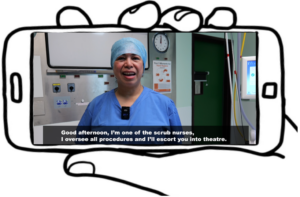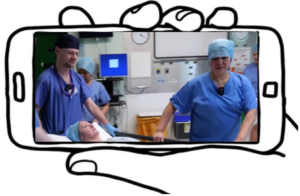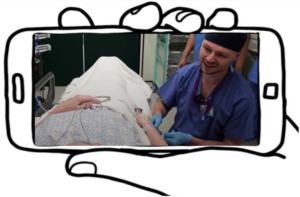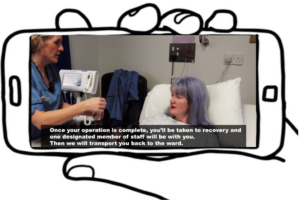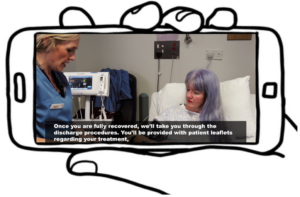This blog reflects the views of the author. The Council of Deans of Health has a wide membership and set of partnerships with a range of opinions that do not necessarily constitute formal positions of the Council. We value that diversity of thought and experience.
Fionnadh Ratchford is a second year nursing student from the University of the West of Scotland and one of the #150Leaders. In this blog, she showcases how she collaborated with NHS and UWS staff to create a video for Day Surgery service users and highlighted the importance of student-led innovation in advancing education, clinical practice, and leadership development.
The British Government (2024) acknowledge that urgent action is needed to reduce the backlog of surgical procedures. Day surgery contributes to environmental sustainability due to the
- increased use of minimally invasive techniques leading to better outcomes (Johnson et al., 2024).
- reduced use of resources and waiting lists (Thoen et al., 2024).
- faster rates of recovery (Hiesinger et al., 2023).
Yet for many service users, day surgery is their first time accessing healthcare in years. Eberhart et al., (2020) found that anxiety and fear of the unknown were the worst aspects. On placement, I encountered service users unable to find the unit, often arriving late and stressed which could impact theatre lists and change their presenting physiology. I wondered how all of this could be improved.
The Centre for Perioperative Care (2020) state that holistic preparation has been found to improve patient recovery. A video of an individual’s perioperative journey could enhance this experience by addressing concerns (Eberhart et al., 2020); embedding important messages; promote resilience (Berthold and Bormann, 2024); and reducing preoperative anxiety (Kovoor et al., 2021).
Our health service should meet the expectations of all its service users (Schulz and Bohnet-Joschko, 2024) and recent advancements in the developing, implementing and integrating of technology enhanced simulations, and educational videos, offers such opportunities. Environmental sustainability could be achieved as videos can be time efficient for clinicians, reducing their input (Kovoor et al., 2021) and can be viewed many times prior to surgery (Valleser and Narvaez, 2024). They can be cheap to produce and expanded to form a digital health library. Brighton and Sussex Medical School, Centre for Sustainable Healthcare, and UK Health Alliance on Climate Change (2023) describe how digital solutions in comparison to standard methods were associated with reduced carbon emissions, financial savings, reductions in length of hospital stay, and improved environmental sustainability.
As a 2nd year student nurse, and in partnership with the NHS and UWS staff, I created a video for Day Surgery service users (please see the following screen grabs). Russ et al., (2023) identify the need for collaboration between university and the healthcare sectors to improve educational opportunities. Students are ideally placed to contribute to quality improvement activities (Armstrong, Shepherd, and Harris, 2024) whilst learning about how excellence in care is achieved. Initial viewings of this video have been positive, and we are currently looking at impact studies to capture these experiences. I have learned that students can lead and innovate to advance education and clinical practice. I have greater understanding and personal confidence with my nursing education, the development of skills, and the realities of leadership within clinical practice.
Robert Burns, Scotland’s National Poet, born a few miles from the UWS Campus Ayr wrote of the power, “to see oursels as ithers see us!” Simulated practice offers new perspectives leading to innovative opportunities to improve and develop environmentally sustainable healthcare for the benefit of all.
To access the full video please contact student.leadership@cod-health.ac.uk
References:
Armstrong, L., Shepherd, A., and Harris, F. (2024) ‘Experiences of Newly Qualified Nurses’ Engagement with Quality Improvement in Practice: A Qualitative Follow-Up Study’, Nursing Reports, 14(4), pp. 2990-3006. Available at: DOI.org/10.3390/nursrep14040218
Berthold, D.P. and Bormann, M. (2024) ‘Psychological Resilience Promotes Positive Outcomes After Surgery’. Arthroscopy, 40(12), pp. 2895-2896. Available at: DOI.org/10.1016/j.arthro.2024.04.004
Brighton and Sussex Medical School, Centre for Sustainable Healthcare, and UK Health Alliance on Climate Change (2023) Green surgery: Reducing the environmental impact of surgical care. London: UKHACC. Available at: https://www.rcseng.ac.uk/-/media/Files/GreenSurgeryReport2023.pdf (Accessed on: 17-12-2024).
British Government (2024) Build Back Better: Our Plan for Health and Social Care. Available at: https://www.gov.uk/government/publications/build-back-better-our-plan-for-health-and-social-care/build-back-better-our-plan-for-health-and-social-care (Accessed on: 08-11-2024).
Centre for Perioperative Care (2020) National Day Surgery Delivery Pack. Available at: https://cpoc.org.uk/sites/cpoc/files/documents/2020-09/National%20Day%20Surgery%20Delivery%20Pack_Sept2020_final.pdf (Accessed on: 06-12-2024).
Eberhart, L., Aust, H., Schuster, M., Sturm, T., Gehling, M., Euteneuer, F. and Rüsch, D. (2020) ‘Preoperative anxiety in adults – a cross-sectional study on specific fears and risk factors.’ BMC Psychiatry, 20, 140. Available at: DOI.org/10.1186/s12888-020-02552-w
Heisinger, S., Huber, D., Matzner, M.P., Hiertz, H., Lampe, L.P., Zagata, J., Aspalter, S., Radl, C., Senker, W., Mair, G. and Grohs, J.G. (2023) ‘TLIF Online Videos for Patient Education-Evaluation of Comprehensiveness, Quality, and Reliability’. International Journal of Environmental Research and Public Health, 20(5):4626. Available at: DOI: 10.3390/ijerph20054626
Johnson, S.M., Marconi, S., Sanchez-Casalongue, M., Francis, N., Huo, B., Alseidi, A., Alimi, Y.R., Pietrabissa, A., Arezzo, A., Frountzas, M., Bellato, V., Potapov, O., Barach, P., Rems, M., Bello, R.J., Nijhawan, S., Oslock, W.M., Sathe, T.S., Hall, R.P., Miller, B., Samreen, S., Chung, J., Marfo, N., Lim, R.B., Vandeberg, J., Eussen, M.M., Bouvy, N.D. and Sylla, P. (2024) ‘Sustainability in surgical practice: a collaborative call toward environmental sustainability in operating rooms.’ Surgical Endoscopy, 38, pp. 4127–4137. Available at: DOI.org/10.1007/s00464-024-10962-0
Kovoor, J.G., McIntyre, D., Chik, W.W.B., Chow, C.K. and Thiagalingam, A. (2021) ‘Clinician-Created Educational Video Resources for Shared Decision-making in the Outpatient Management of Chronic Disease: Development and Evaluation Study.’ Journal of Medical Internet Research, 23(10): e26732. Available at: DOI: 10.2196/26732
Russ D., Whiteing, N. and Aggar, C. (2023) ‘An integrative review of nursing students’ clinical placement experiences throughout their nursing degrees’. Collegian, 30(1), pp.154-162. Available at: DOI:org/10.1016/j.colegn.2022.07.002
Schulz, A. and Bohnet-Joschko, S. (2024) ‘Enhancing patient informed consent in elective skin cancer surgeries: a comparative study of traditional and digital approaches in a German public hospital’, BMC Health Services Research, 24(1)879. Available at: DOI.org/10.1186/s12913-024-11225-3
Thoen, C.W., Sæle, M., Strandberg, R.B., Eide, P.H. and Kinn, L.G. (2024) ‘Patients’ experiences of day surgery and recovery: A meta-ethnography.’ Nursing Open, 11(1): e2055, pp.1-16. Available at: DOI: 10.1002/nop2.2055
Valleser, C.F. and Narvaez, R.A. (2024) ‘Effectiveness of Video-Discharge Instructions and Multi-media on Patients with Colostomy’. International Journal of Caring Sciences, 17(2), pp. 933-950. Available at: https://www.internationaljournalofcaringsciences.org/docs/28.-narvaez.pdf (Accessed on: 25-09-2024).




